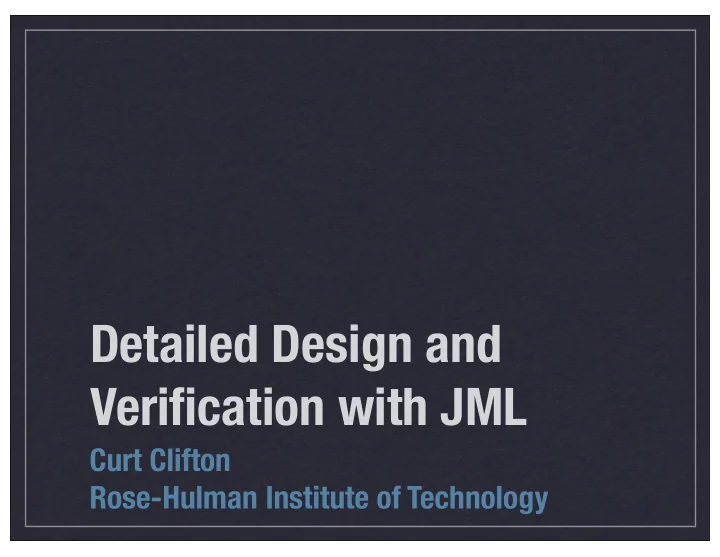

Detailed Design and Verification with JML Curt Clifton Rose-Hulman Institute of Technology
And now for something completely different
And now for something completely different
Course Topics DETAILED DESIGN AND VERIFICATION (JML) ABSTRACTIONS (ALLOY) 0 2 4 6 8 10 REACTIVE SYSTEMS Week HW 7 due Thursday, 6am (STATE CHARTS)
Formal Verification Formal reasoning about actual code Application: Design-by-contract Weakest pre-condition calculation Proving program correctness
The Plan First, learn basic reasoning techniques Working by hand Using same notation that we’ll automate later Then, experiment with prototype tools for automated reasoning
JML: Notation and Tools
What’s JML? JML stands for “ Java Modeling Language ” A Behavioral Interface Specification Language A “BISL” specifies the signatures of functions, methods, and classes— the interface Conditions that must hold— the behavior JML extends Java with special annotations for behavioral specifications Q1,2
JML Annotations Annotations in JML are just Java comments JML tools recognize comments using ‘@’ symbol //@ starts a single line annotation //@ requires x > 0; /*@ … */ defines a multi-line comment Common mistake—adding a space: // @ NOT VALID! BEGIN Q3
Example PRECONDITION: WHAT CALLER MUST GUARANTEE /*@ requires x > 0; @ ensures \result * \result <= x && @ x < (\result + 1) * (\result + 1); @*/ public static int iroot(int x) { … } POSTCONDITION: WHAT METHOD MUST ENSURE FINISH Q3
One use for JML: Design by Contract A software development methodology Engineer specifies a contract for each method: A precondition and A postcondition Programmer implements the methods Q4
Executable Java with Runtime Static Checks Warnings Unit Tests OpenJML 7 jmlc4 Runtime Data JMLUnitNG Traces Daikon Java Annotated With JML bogor Model Checking JACK, Jive, Krakatoa, jmldoc KeY, LOOP HTML Documentation Proofs of Correctness WHAT’S THE USE? THE FAMILY OF JML TOOLS
Techniques for Formal Verification, or …
How Do You Eat an Elephant? ONE BITE AT A TIME
First Bites Assignment Sequencing
Detailed Notation Low-level verification: use JML’s assert … //@ assert n == 0; Pre-condition: before a i = 0; statement or block //@ assert n == i; … Post-condition: after a statement or block WHY NOT JUST USE JAVA’S ASSERT STATEMENT? Q5
Proving Program Properties PARTIAL CORRECTNESS Specify the program with pre- and post-conditions Use “inference rules” to annotate the program proving that from the pre-condition we can reach the post-condition Show that loops and recursive functions terminate TOTAL CORRECTNESS
Assignment Rule WHAT MUST BE TRUE ABOUT e WHATEVER IS //@ assert P(e) ; BEFORE IF WE WANT TRUE ABOUT e v = e ; SOME PROPERTY TO BEFORE IS TRUE //@ assert P(v) ; BE TRUE ABOUT v ABOUT v AFTER AFTER?
The Weakest Precondition is… THE LEAST RESTRICTIVE PRE-CONDITION SUCH THAT THE POST-CONDITION MUST HOLD. Q6
Examples… //@ assert P(e) ; v = e ; //@ assert P(v) ; Q7,8
Examples 2: //@ assert 11 == y; 1: //@ assert 14 - 3 == y; x = 3; //@ assert 14 - x == y; 2: //@ assert 100 <= n * 3 && n * 3 < p; 1: n’ = n * 3; // tick trick //@ assert 100 <= n’ && n’ < p;
Composition Rule IF: //@ assert P 1 ; THEN: S 1 ; //@ assert P 1 ; //@ assert Q 1 ; S 1 ; AND //@ assert Q 1 ; //@ assert P 2 ; //@ assert P 2 ; S 2 ; S 2 ; //@ assert Q 2 ; //@ assert Q 2 ; AND Q 1 ==> P 2 IMPORTANT: IMPLICATIONS GO DOWN Q9
Composition Example 3: //@ assert 3 * (x + y) > 10; 2: x’ = x + y; // tick trick 1: //@ assert 3 * x’ > 10; y = 3 * x; //@ assert y > 10;
Recommend
More recommend